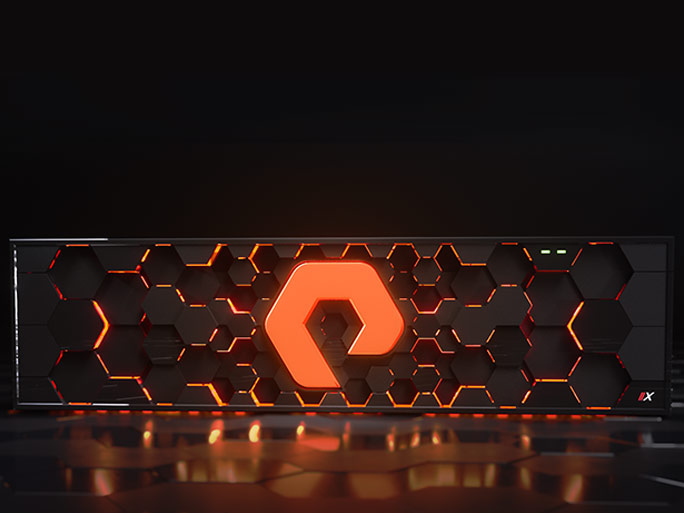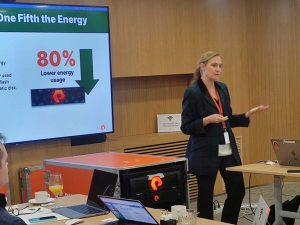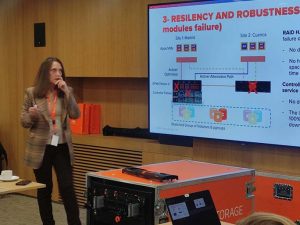Pure Storage Showcases the Dynchronisation of its FlashArray Units

Pure Storage, during its presentation “we innovate, we demonstrate”, has shown the performance of its FlashArray units.
During the presentation “We innovate, we demonstrate”, Pure Storage has made a review of the current supply chain and sustainability, the technological innovations of the company’s portfolio have been shown, and a demonstration has been made on how the FlashArray cabinets work.
Pure Storage is a company that has grown 647 million dollars during the last quarter, which means a growth of 30% over the same period last year.
Sustainability and Supply Chain
Adela de Toledo, Country Manager of Pure Storage Iberia, started the presentation by talking about the supply chain and sustainability. Pure Storage defines the modern data centre by means of an All Flash structure and strategy with a cloud-based operating model, “where simplicity based on the cloud is the raison d’être”, defined by de Toledo.
This definition is based on 5 growth strategies focused on “gaining market share in data centre modernisation, an all-flash strategy, cloud operating model, evergreen subscriptions and hyper scalability”, says de Toledo.
Sustainability
Pure Storage’s market differentiators are preceded by its philosophy focused on achieving “high-density storage design and performance through sustainability-based construction,” said de Toledo. “We have a higher density in storage as the units are smaller and have a much lower energy requirement, being very efficient in energy consumption, and with the possibility of upgrading we contribute to the evergreen part without the need to change platforms, which ensures sustainability,” said de Toledo.

“On a general level, we can say that, due to the design characteristics, we save up to 80% of energy compared to our competitors, as they are smaller and need less cooling, so they are more efficient,” said de Toledo.
Supply Chain
Regarding the supply chain, according to de Toledo, Pure Storage “has a delivery time of 6 weeks, compared to 3 and 6 months for our competitors. This is due to the multi-geographic strategy of locating the supply chains close to the countries with the highest demand, which allows us to react quickly in case of urgency. Our Capacity Planning allows us to predict in order to reduce delivery times”.
Innovation
Carmen Derlinchan, Senior Systems Engineering Director of Pure Storage Iberia, has been in charge of presenting the innovation strategy that the company has followed.
Derlinchan began her presentation with a historical review of the most important milestones that Pure Storage has reached throughout its history. Among them, is the adoption of an All Flash strategy in its products, offering smaller memories with a higher density but with the capacity to be interchangeable.
During the presentation, Derlinchan made special emphasis on the fact that Pure Storage was the first company to use flash memories for enterprise storage: “which means a groundbreaking change in the market”. In this sense, the fact that the memories are interchangeable is in line with the evergreen business model that the company adopted in 2014, with which it achieved the best TCO in the market and greater sustainability.

Pure Storage Portfolio
Regarding the portfolio offered by Pure Storage, Derlinchan clarified the rebranding that the company’s products have undergone. The “Gold” and “Pure as a Service” services are now called “Evergreen Forever” and “Evergreen One” respectively. In terms of product innovations, “Evergreen Flex” represents a mix of the two previous options.
The latter is a subscription service whereby customers purchase software and hardware at the start of their project, while Pure Storage is responsible for providing the project with the necessary infrastructure to provide the capacity, performance, time and SLA required by the service, and paying in proportion to the usage used.
Derlinchan also highlighted Pure Storage’s role in offering “Infrastructure as a Code”, also known as Infrastructure as a Service. This model allows customers to purchase a pre-defined storage model, so that service acquisition can be performed quickly and simply, with the relevant time reduction that large projects require.
Active-Active Data Center Demonstration
Finally, Victor Sánchez, responsible for presales partners at Pure Storage Iberia, gave a demonstration of how the FlashArray works. During the demonstration, a case was presented in which two FlashArray units, representing data centres that are physically distant from each other, were configured to work together and simultaneously to avoid data loss during storage in the event of any type of failure.
To configure the cabins, the only technical requirement is to obtain the private key from one of them, while in the other cabin you only have to configure the replication of the data. By simply entering the IP of the adjacent booth with which you want to establish a relationship and establishing the type of synchronisation you want to perform, you can see on both dashboards how both booths have synchronised and are recording the same data simultaneously, thus achieving the mirroring effect.
Simulation of connection loss
To simulate the loss of connection in data logging, Victor Sanchez has first of all completely unplugged one of the cabins. Secondly, he also demonstrated that the system works just as efficiently in the event of component failure. In this second case, he simulated the failure of 2 flash memory units and a controller.
When one of the two cabins detects a data logging failure in the other cabin, it starts logging the data intended to be stored in the failed cabin locally. This process does not take up to 8 seconds, so the application server running Windows 7 does not detect data logging and storage failures and continues to operate even if there is no synchronisation between the cockpits.
Automatic recovery of the FlashArray
In such a scenario, Pure Storage’s storage system has a Cloud Mediator, which acts as an arbiter between the different data centres, and determines which FlashArray units are in charge of supplying the registry and data storage.
Once the connection has been re-established, the Cloud Mediator redirects the writing and reading of data to the cabinet that was predefined for this purpose and instructs the cabinet that was replacing the failed cabinet to send the data it has been recording during the disconnection.
By means of this modus operandi, Pure Storage is able to guarantee parity in the replicas of the data recording in both booths of close to 100% continuously. In this way, the company guarantees that the business applications do not go down at any time and Business Continuity is allowed in all the operations that require permanent data storage.